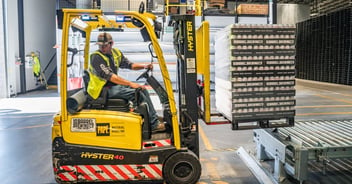We rely on safety professionals to gain insight on real life working conditions, regulations, and best practices all working together to form the safety programs we see in companies all over the world. One of those professionals, Abby Ferri, explains her take on the role of technology in today’s safety training and the possibilities that await us in the future.
Abby is the founder and president of The Ferri Group, a safety consulting company based in Minneapolis, MN. She provides services covering employee safety training, insurance risk control, and other safety-related consultations. A safety expert with experience across multiple industries, Abby provides a great understanding of some of the difficulties in the safety business.
What Stands In The Way?
Picture this: You’ve got a hundred or so employees representing diverse roles in the workplace, and they all need to complete safety training. You have one safety professional and two hours to make it happen. What do you think the biggest hurdles will be?
According to Abby, those hurdles are time and employee engagement.
“It always seems like we never have enough time to deliver the training that we need to do,” she said. You may have a four-hour training course that covers the topics that the employees need, but you only have two hours of company time to use.
Her advice? Plan ahead and use your time wisely. “I think that safety professionals could be more efficient in how we deliver training,” said Abby. “So instead of lopping off part of the training, how can you make your training better?”
Following this advice, it’s best to alter your training in a way that reduces time and benefits learners at the same time. One way to do this is by making the training as specific as possible, Abby points out. Find the specific problems facing this workplace and these employees, and educate them on the most relevant points within the training. This saves time and creates a more efficient training session.
How Engaged Are Your Learners?
That second hurdle facing safety trainers is employee engagement. “A lot of times, people are working long hours, or the content just isn’t that exciting, or it’s not being delivered in a way that really reflects the adult learning principles,” said Abby. If this is the case, the information isn’t being retained and your training is unsuccessful.
She’s got a few helpful tips for employee engagement strategies that have been tested and proven successful in her experience:
-
Keep it relevant.
-
Tie in hands-on training.
-
Review your content beforehand.
-
Incorporate games.
-
Create smaller groups or pairs.
Abby likes to use resources from other safety consultants as well, like Linda Tapp’s SafetyFUNdamentals, along with her own library of previously successful games and activities. Resources like these give you so many options to choose from when you’re working to create effective safety training content.
Employee engagement is just one of those things that is difficult to plan for. It’s best to scope out what you’re working with ahead of time in terms of employees and the classroom space so that you know what to prepare and what might work best.
What Does The Future Of Safety Training Hold?
It’s easy to stay in the here and the now, but what about safety professionals who are looking to the future? The future of safety training is already being molded. We can see some of the paths that are already being created, and we are even imagining what will come next after that. From what we can see so far, technology is definitely taking a step forward in safety. But what does this mean?
Abby Ferri is a bit skeptical yet optimistic. “I really do enjoy classroom training, but I feel like it’s going away to things like micro module types of training,” she said, “so I feel like that really is the future, but I think it needs to be integrated with other things.”
Online training has certainly taken hold. It can be a really useful tool with plenty of benefits, but Abby still wants to see some of that old-fashioned human interaction at work. “So even though technology is going to help us a lot in the safety field, it’s still relationship-driven,” she said. “We still need that contact between a trainer and a classroom to really get the safety message across.”
She makes a great point. Technology can be a powerful supplement to our jobs and our lives, but it doesn’t replace our minds, our relationships, or our safety professionals. We can use our new advancements to streamline basic tasks, but that just means that we give ourselves more time to focus our time and energy on what’s really important.
Technology can’t make the judgement calls needed on the job as a safety professional. Sure, it can probably help out with a lot; but can it pare down a training course to fit that two-hour time slot while maintaining its effectiveness for the employees it’s never met? Can it tell if your learners are effectively engaged with the material and adjust accordingly?
Our advancements in technology have already improved safety around the world, but it can’t stand alone. We look forward to witnessing further progress as we combine our human qualities with our technological creations to shape the future of the workplace.






Leave a Comment